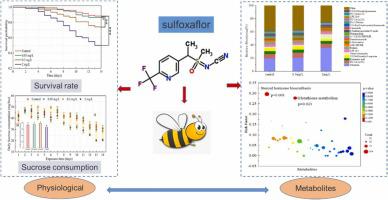Journal of Hazardous Materials ( IF 12.2 ) Pub Date : 2022-10-04 , DOI: 10.1016/j.jhazmat.2022.130109 Shenhang Cheng 1 , Pingli Dai 2 , Ren Li 1 , Zhibin Chen 1 , Pingzhuo Liang 1 , Xiaoping Xie 3 , Congai Zhen 1 , Xiwu Gao 1

|
Honeybees (Apis mellifera) are indispensable pollinators in agricultural production, biodiversity conservation, and nutrients provision. The abundance and diversity of honeybees have been rapidly diminishing, possibly related to the extensive use of insecticides in ecosystems. Sulfoxaflor is a novel sulfoximine insecticide that, like neonicotinoids, acts as a competitive modulator of nicotinic acetylcholine receptors (nAChR) in insects. However, few studies have addressed the negative effects of sulfoxaflor on honeybees at environmentally relevant concentrations. In the present study, adult workers were fed a 50% (w/v) of sugar solution containing different concentrations (0, 0.05, 0.5 and 2.0 mg/L) of sulfoxaflor for two weeks consecutively. The survival rates, food intake, and body weight of the honeybees significantly decreased after continuous exposure at higher doses (0.5 and 2.0 mg/L) of sulfoxaflor when compared with the control. The change in the metabolites in the honeybee gut was determined using high-throughput non-targeted metabolomics on day 14 after sulfoxaflor treatment. The results revealed that 24 and 105 metabolites changed after exposure to 0.5 and 2.0 mg/L sulfoxaflor, respectively, compared with that of the control groups. A total of 12 changed compounds including pregenolone and glutathione were detected as potential biomarkers, which were eventually found to be enriched in pathways of the steroid hormone biosynthesis (p = 0.0001) and glutathione metabolism (p = 0.021). These findings provide a new perspective on the physiological influence of sulfoxaflor stress in honeybees.
中文翻译:

亚砜亚胺杀虫剂 sulfoxaflor 的暴露降低了蜜蜂的生存状态并破坏了蜜蜂的肠道代谢 Apis mellifera
蜜蜂 ( Apis mellifera )) 是农业生产、生物多样性保护和养分供应中不可或缺的传粉媒介。蜜蜂的数量和多样性正在迅速减少,这可能与生态系统中杀虫剂的广泛使用有关。Sulfoxaflor 是一种新型亚砜亚胺杀虫剂,与新烟碱类药物一样,可作为昆虫中烟碱乙酰胆碱受体 (nAChR) 的竞争性调节剂。然而,很少有研究涉及在环境相关浓度下磺胺嘧啶对蜜蜂的负面影响。在本研究中,成年工人连续两周被喂食含有不同浓度(0、0.05、0.5 和 2.0 mg/L)磺胺嘧啶的 50% (w/v) 糖溶液。存活率、食物摄入量、与对照组相比,连续暴露于较高剂量(0.5 和 2.0 mg/L)的磺胺嘧啶后,蜜蜂的体重和体重显着下降。蜜蜂肠道中代谢物的变化是在磺胺嘧啶处理后第 14 天使用高通量非靶向代谢组学测定的。结果显示,与对照组相比,在暴露于 0.5 和 2.0 mg/L 磺胺嘧啶后,分别有 24 和 105 种代谢物发生了变化。共检测到 12 种变化的化合物,包括 pregenolone 和谷胱甘肽作为潜在的生物标志物,最终发现它们富含类固醇激素生物合成的途径。蜜蜂肠道中代谢物的变化是在磺胺嘧啶处理后第 14 天使用高通量非靶向代谢组学测定的。结果显示,与对照组相比,在暴露于 0.5 和 2.0 mg/L 磺胺嘧啶后,分别有 24 和 105 种代谢物发生了变化。共检测到 12 种变化的化合物,包括 pregenolone 和谷胱甘肽作为潜在的生物标志物,最终发现它们富含类固醇激素生物合成的途径。蜜蜂肠道中代谢物的变化是在磺胺嘧啶处理后第 14 天使用高通量非靶向代谢组学测定的。结果显示,与对照组相比,在暴露于 0.5 和 2.0 mg/L 磺胺嘧啶后,分别有 24 和 105 种代谢物发生了变化。共检测到 12 种变化的化合物,包括 pregenolone 和谷胱甘肽作为潜在的生物标志物,最终发现它们富含类固醇激素生物合成的途径。p = 0.0001) 和谷胱甘肽代谢 ( p = 0.021)。这些发现为蜜蜂磺胺嘧啶应激的生理影响提供了新的视角。











































 京公网安备 11010802027423号
京公网安备 11010802027423号